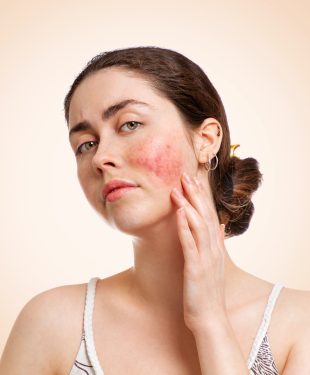
Top Skin Conditions And How To Manage Them
Whether it’s oily, acne-prone, sensitive or prone to redness, everyone has a different skin type with its own unique challenges. The top skin concerns are all too common and can leave even the most confident of us feeling insecure. Imperfections and blemishes don’t just appear out of nowhere. They’re usually triggered by a combination of factors that include genetics, stress levels, lifestyle and diet. With this in mind, these common skin problems are manageable. In this guide, we’ll cover the most common skin conditions and how you can manage them.
What Are Skin Conditions?
Our skin is our biggest organ, so it makes sense it would be susceptible to a number of conditions, many of which are caused or exacerbated by external circumstances. Skin conditions can be temporary, long-term, genetic, or caused by external factors like everyday skincare products, the sun or stress. Some of the most common skin conditions include:
- Acne
- Eczema
- Psoriasis
- Rosacea
- Shingles
- Hives
- Contact Dermatitis
- Sunburn
- Athlete’s Foot
Speaking To Your Doctor
Before you begin adjusting your skincare routine, it’s important you speak to your doctor. They’ll be able to identify the underlying cause of your skin condition and prescribe the most effective treatment. This could be a change to your diet, topical treatments or even prescription medication. Certain conditions, such as rosacea and psoriasis, can’t be cured. It’s up to you to manage them with the right products and by following a skincare routine that’s tailored to your specific condition. Your doctor can help you to create a treatment plan that’ll make managing your skin much easier.
Eczema
Eczema is a skin condition that causes itching, redness and dry, scaly patches on the skin. Eczema is thought to be caused by a combination of genetic and environmental factors. Certain factors may worsen eczema, such as stress, infection, stress, abnormal pH levels and certain foods. Treatment for eczema usually involves topical creams, ointments and moisturisers. Eczema can be a lifelong condition and is easily triggered, so it’s important always to use gentle skincare products and moisturisers.
Acne
Acne is a common skin condition that causes blackheads, whiteheads and pimples. It’s caused by a build-up of bacteria in the pores. Acne is most common in adolescence, but it can affect people of all ages. Treatments for acne usually involve topical creams, ointments, cleansers and sometimes medication. The most important thing when managing acne is to make sure you clean your skin properly. This will help to reduce the number of bacteria in the pores and prevent breakouts.
Shingles
Shingles is a painful rash caused by the varicella-zoster virus, which is the same virus that causes chickenpox. There are treatments for shingles, but it’s important to see your doctor as soon as you recognise the symptoms. The rash is contagious and can be passed on to other people. It’s also important you don’t scratch the rash, as this can lead to scarring. Instead, use gentle skincare products and moisturisers to soothe the rash. For more information about shingles, take a look at the helpful advice from Patient.
Rosacea
 Rosacea is a common skin condition that causes redness, breakouts and a tendency towards sensitivity. It’s caused by an increase in blood flow in the face, which can lead to redness. Treatments for rosacea usually involve topical creams and ointments. It’s important to keep your skin hydrated and use gentle skincare products. Products with scents and alcohol should be avoided as they can exacerbate the condition.
Rosacea is a common skin condition that causes redness, breakouts and a tendency towards sensitivity. It’s caused by an increase in blood flow in the face, which can lead to redness. Treatments for rosacea usually involve topical creams and ointments. It’s important to keep your skin hydrated and use gentle skincare products. Products with scents and alcohol should be avoided as they can exacerbate the condition.
Psoriasis
Psoriasis is a skin condition that causes patches of dry, scaly skin. It’s not contagious, but it can be uncomfortable and embarrassing. There’s no cure for psoriasis, but certain skincare products can help to relieve the condition and prevent the patches from flaring up. Products that are packed with soothing ingredients, such as aloe vera, green tea and jojoba oil, can be helpful for managing psoriasis. You should also look for products that use natural preservatives and don’t contain any alcohol. When it comes to your skincare routine, it’s important to find the right product for the condition of your skin.
Hives
Hives are small, raised patches of skin that are often red. They usually go away after a few days, but sometimes they last longer. Hives are typically caused by an allergic reaction to something that has come into contact with the skin. A lot of things can trigger hives, including foods, medications, stress and even pollution. Treatments for hives will depend on the underlying cause. In many cases, antihistamines will be enough to bring the hives under control.
Sunburn
Sunburn is caused when you are exposed to high levels of UV (ultraviolet) light, either from the sun or from sunbeds. It’s important to remember that even when the sun isn’t visible, it’s still dangerous. The sunburn you get on a cloudy day is just as damaging as the one you get on a sunny day. There are treatments for sunburn, but it’s important to catch it early. You can soothe the pain and redness with aloe vera and other skincare products. To avoid getting sunburn, make sure you use plenty of sun cream when you’re going to be spending time outdoors, even if the weather is cloudy. It also doesn’t matter what time of day it is, as UV rays can cause damage when the sun isn’t shining.
Contact Dermatitis
Contact dermatitis is an inflammation of the skin caused by coming into contact with an allergen. Contact dermatitis can happen at any age and affects both men and women. It can be caused by a number of different factors, including cosmetics, soaps, perfumes, certain fabrics, detergents and solvents. Treatments for contact dermatitis will depend on the cause. It’s important to identify the trigger with the help of your doctor and avoid it as much as possible.
Athlete’s Foot
Athlete’s Foot is a common fungal infection that causes itchiness and redness. Athlete’s Foot is an infection caused by fungi that thrive in warm, moist environments. It usually appears between the toes but can spread to other areas of the foot, including the heel and the sole. It’s more common in people who wear tight-fitting shoes, sweat excessively or have poor foot hygiene. Athlete’s Foot is caused by a fungus that grows on the skin. You can get the infection by walking barefoot in public places, sharing clothing with someone who has it or wearing wet or dirty clothes for long periods of time. There are many treatments to help reduce and prevent a fungal infection. A doctor can prescribe an antifungal cream to clear up the infection as well as provide you with advice on how to reduce the likelihood of contracting Athlete’s Foot again. A top tip for avoiding it in public places like gym showers is to use flip-flops instead of walking barefoot.
Final Thoughts
Different skin types and conditions can be managed with the right treatments. It’s important to keep your skin clean, moisturised and hydrated. You can do this by eating a healthy diet and using the right skincare products. It’s also important to protect your skin from UV rays when you’re outside and speak to your doctor if you have any concerns.
